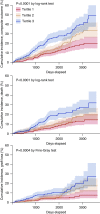Osmoregulation Performance and Kidney Transplant Outcome
- PMID: 31217325
- PMCID: PMC6622417
- DOI: 10.1681/ASN.2018121269
Osmoregulation Performance and Kidney Transplant Outcome
Abstract
Background: Kidney transplant recipients have an impaired ability to dilute urine but seldom develop baseline hyponatremia before ESRD. Although hyponatremia is a risk factor for adverse events in CKD and in kidney transplant recipients, it remains unclear whether subtler alterations in osmoregulation performance are associated with outcome.
Methods: We studied a single-center prospective cohort of 1258 kidney transplant recipients who underwent a water-loading test 3 months after transplant to determine osmoregulation performance. Measured GFR (mGFR) was performed at the same visit. A group of 164 healthy candidates for kidney donation served as controls. We further evaluated the association of osmoregulation performance with transplantation outcomes and subsequent kidney function.
Results: Unlike controls, most kidney transplant recipients failed to maintain plasma sodium during water loading (plasma sodium slope of -0.6±0.4 mmol/L per hour in transplant recipients versus -0.12±0.3 mmol/L per hour in controls; P<0.001). Steeper plasma sodium reduction during the test independently associated with the composite outcome of all-cause mortality and allograft loss (hazard ratio [HR], 1.73 per 1 mmol/L per hour decrease in plasma sodium; 95% confidence interval [95% CI], 1.23 to 2.45; P=0.002) and allograft loss alone (HR, 2.04 per 1 mmol/L per hour decrease in plasma sodium; 95% CI, 1.19 to 3.51; P=0.01). The association remained significant in a prespecified sensitivity analysis excluding patients with hyperglycemia. In addition, a steeper plasma sodium slope 3 months after transplantation independently correlated with lower mGFR at 12 months (β=1.93; 95% CI, 0.46 to 3.41; P=0.01).
Conclusions: Reduced osmoregulation performance occurs frequently in kidney transplant recipients and is an independent predictor of renal outcome.
Keywords: Sodium; kidney transplantation; osmoregulation.
Copyright © 2019 by the American Society of Nephrology.
Figures




Comment in
-
A "Set Point" for Water Homeostasis Disturbed with Altered Kidney Transplantation Outcome.J Am Soc Nephrol. 2019 Jul;30(7):1141-1143. doi: 10.1681/ASN.2019050472. Epub 2019 Jun 19. J Am Soc Nephrol. 2019. PMID: 31217326 Free PMC article. No abstract available.
References
-
- Wolfe RA, Ashby VB, Milford EL, Ojo AO, Ettenger RE, Agodoa LY, et al. .: Comparison of mortality in all patients on dialysis, patients on dialysis awaiting transplantation, and recipients of a first cadaveric transplant. N Engl J Med 341: 1725–1730, 1999 - PubMed
-
- Legendre C, Canaud G, Martinez F: Factors influencing long-term outcome after kidney transplantation. Transpl Int 27: 19–27, 2014 - PubMed
-
- Bourque CW: Central mechanisms of osmosensation and systemic osmoregulation. Nat Rev Neurosci 9: 519–531, 2008 - PubMed
-
- Hiyama TY, Noda M: Sodium sensing in the subfornical organ and body-fluid homeostasis. Neurosci Res 113: 1–11, 2016 - PubMed
-
- Bonilla-Felix M: Development of water transport in the collecting duct. Am J Physiol Renal Physiol 287: F1093–F1101, 2004 - PubMed
MeSH terms
Substances
LinkOut - more resources
Full Text Sources
Medical

